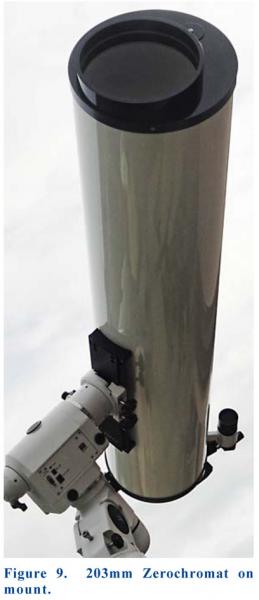The dialyte refractor revisited
2017 November 18
 Following a visit to Hanwell Observatory to see John Wall’s 760mm (30-inch) dialyte refractor, I vowed to create an instrument to embody the basic principles in an affordable instrument for amateurs. The Hanwell 760mm dialyte is reported to be the world’s equal-5th largest refractor and is the largest in the United Kingdom. It was made entirely by John Wall, even the objective lens.
Following a visit to Hanwell Observatory to see John Wall’s 760mm (30-inch) dialyte refractor, I vowed to create an instrument to embody the basic principles in an affordable instrument for amateurs. The Hanwell 760mm dialyte is reported to be the world’s equal-5th largest refractor and is the largest in the United Kingdom. It was made entirely by John Wall, even the objective lens.
A letter in the BAA Journal in 2007 October outlined the work done by both John Wall and myself on retrofocally corrected dialyte refractors. Another paper of interest appeared in the Journal in 2002. The dialyte configuration consists of a singlet objective lens followed by other lenses to correct for chromatic aberration introduced by the objective lens. In John Wall’s design, the field lens is placed beyond the objective’s uncorrected focus, followed by a series of corrective lenses to remove or reduce chromatic aberration, spherical aberration, and other optical defects.
Traditional refractors employ at least two objective elements to correct for chromatic aberration. There are instruments with up to four elements for the objective lens, often using low-dispersion glass types, such as fluorite or calcium fluoride to improve optical performance. These latter can cost 30 to 50 times more than standard crown glass, such as BK7, with added problems of difficulty in manufacture, high weight at the front end and slow cool-down times. The largest achromatic refractor is the 40-inch (1.016m) Yerkes, and the largest apochromat refractor to date is 21 inches (0.53m) at the Vatican Observatory.
The greatest problem with apochromatic refractors larger than 200mm is that standard pieces of suitable low-dispersion glass as one or more of the essential elements of the objective lens are only available up to 200mm in diameter. Larger pieces have to be specially cast, which is a very expensive exercise.
After many months of careful design work with an optical design program, Sinclair Optics’ OSLO (www.sinopt.com), developed at Rochester University in the 1970s, and in consultation with other optical designers, the first 203mm retrofocally corrected dialyte refractor came into being. Two of these were made, and the performance was exactly up to expectations.(Login or click above to view the full illustrated article in PDF format)
| The British Astronomical Association supports amateur astronomers around the UK and the rest of the world. Find out more about the BAA or join us. |
